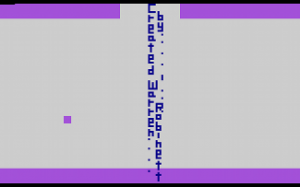Deep Exploration: 32 Ideas for making exploration more interesting in CRPGs
Posted by Rampant Coyote on March 27, 2013
In computer RPGs, there are a number of gameplay “loops” or cycles that all interact with each other. A nice blend of cycles keeps the game varied and interesting. You’ve got the combat cycles – nice, repeating elements that (hopefully!) stay varied enough between different enemies and growing player character power and varying resources that it’s never a complete repetition. And of course, the character growth and loot cycles. And bits of exposition (not really a cycle) to keep the context changing.
 For me, exploration is a major element of CRPGs. The whole Star Trek opening monologue captures the spirit of adventure for me. Sure, there may be swashbuckling or grim battles to fight and fantastic loot to be acquired, and of course expertise to be gained – but those are all secondary, or at least co-equal, to the feeling of exploration for me. Even if the entire game takes place within the well-trodden streets of a city, where I’m boldly going where many-a-person has gone before, I want find secrets, surprises, and wonder around every corner. Maybe that’s a projection of my optimism for the real world into games, but that’s how I am.
For me, exploration is a major element of CRPGs. The whole Star Trek opening monologue captures the spirit of adventure for me. Sure, there may be swashbuckling or grim battles to fight and fantastic loot to be acquired, and of course expertise to be gained – but those are all secondary, or at least co-equal, to the feeling of exploration for me. Even if the entire game takes place within the well-trodden streets of a city, where I’m boldly going where many-a-person has gone before, I want find secrets, surprises, and wonder around every corner. Maybe that’s a projection of my optimism for the real world into games, but that’s how I am.
Of course, those efforts must be rewarded. If you play a (well-designed) RPG in the style of 16-bit JRPGs, you’ll often find that almost every extended “dead-end” path terminates with a chest with a treasure in it. It may not make much sense from a realism perspective, but as a game mechanic, it rewards thorough exploration. This also extends the game (from a development perspective), as this kind of “content” is pretty easy to generate, and causes the player not only to consume this “cheap” content. It also slows the play down as the player actively hunts for these kinds of rewards, making the game longer. Overdo it, and it becomes boring “filler.” But done right, it’s fun stuff that rewards careful, exploration-based gameplay.
But there should be a lot more than that. More to do than just wander down side paths, and more to the rewards than just chests with a bonus potion.
The trick in CRPGs is that this kind of content gets EXPENSIVE. That’s a big part of the reason this genre of game is known to be a budget-breaker. And no, before you say it, purely dynamic content is not the answer. Maybe part of the answer (it certainly makes for interesting rewards, as Diablo-style games easily attest), but certainly not the whole answer. ‘Cuz basically, once you’ve gotten a feel for the formulas at work, exploring dynamically generated environments has only slightly more excitement than hunting down prime numbers in math.
 I just thought I’d break down a bunch of ideas – most of which have appeared in some CRPGs in the past (especially if you include Frayed Knights – I experimented with a few of ideas for that) – for both the different ways you can explore content – adding extra dimensions to the exploration gameplay cycle, and for the kinds of rewards that can be obtained for doing so.
I just thought I’d break down a bunch of ideas – most of which have appeared in some CRPGs in the past (especially if you include Frayed Knights – I experimented with a few of ideas for that) – for both the different ways you can explore content – adding extra dimensions to the exploration gameplay cycle, and for the kinds of rewards that can be obtained for doing so.
Adding depth to the exploration mechanic can be a little perilous. It’s not hard for things to get bogged down this way, particularly if it involves returning to previously-explored areas (backtracking) in a large game-world with slow navigation, or if the system is too plodding and methodical. (Yeah, I know, I’m working on improving that with FK2 searches). These should be recurring mechanics in the game – not only does that economize on content & code creation (you don’t want to spend so much time on a one-off effect, do you?), but it also then provides a “skill” for the player (not the character) to learn and master – recognizing and acting on these opportunities. Here are a handful of ideas:
Here are some ideas for layers / depth / interaction to the exploration mechanic, or in many cases to create obstacles or puzzles to free navigation. Some are pretty common, others – not so much:
Sixteen ways to use the exploration mechanic:
#1 – Movement – you go somewhere and something happens.
#2 – Interaction – you must click on something to explore what it does / says
#3 – Hidden interaction. Like #2 but it’s not obvious – like a secret door, or a sword tucked away in the corner. Care must be taken to make sure these aren’t TOO hidden, or the game becomes a “hunt the pixel” exercise.
#4 – Use a skill or ability or a tool (item) in a particular spot to reveal a secret – for example, Mario ducking on pipes to discover the ones with “secrets” in Super Mario Brothers
#5 – Using a skill or ability or a tool (item) in a particular spot to reach an otherwise unattainable location.
#6 – Illusionary obstacles – like an illusionary wall or a hidden bridge across a chasm.
#7 – Destroyable obstacles. Particularly ones that can’t be destroyed by chopping at it with a hand weapon.
#8 – Sequences of actions done in a particular spot – these are usually either explained to the player or strongly hinted at.
#9 – Luring a computer-controlled entity (example: NPC, enemy, or a trap effect) to unlock the environment in a way the player cannot by himself.
#10 – The world / information / rewards change with time – perhaps as the game progresses, with the seasons, or just time of day. Silent villagers during the day are talkative at night, moongates shift position and destination based on phases of the moon, etc. Or as a really weird idea, what if the player could experience “flashbacks” in various locations to what happened at an earlier time as they learn more about the world?
#11 – New ability reveals all-new information / objects / alternate versions of the world. Maybe a dog added to the party can “see” smells that were previously invisible, or the player character can “phase shift” into a shadowy unpopulated alternate dimension version of the same world.
#12 – Proximity Clues – the player is not given the exact location of what they are looking for, but may explore with hints revealing either the approximate location (maybe an area to be searched), or as in Frayed Knights, updates as to whether you are getting “warmer” or “colder” as you search.
#13 – Need special equipment or vehicle to pass – perhaps scuba gear to explore an underwater area, or a magic carpet to fly over an impassible mountain range. This differs from #5 in that it’s not a specific action done in a particular location, but rather the possession (or equipping) of the item allows access to all terrain of of this kind.
#14 – A physical or mental puzzle is required to explore deeper. Dungeon Master style games – like the recent Legend of Grimrock – are full of these.
#15 -Counters. While it’s very “gamey,” having a running counter of the number of undiscovered secrets (possibly broken down by type) can help motivate players and also let them know when to quit digging around every nook and cranny. Ideally, these would be explained through some kind of mechanic that makes sense within the context of the world, but even a totally external mechanic is often better than nothing, depending upon the style of game.
#16 – Mood / Reputation / Faction / Alignment / Progress shifts – the world (or at least the willingness of people to talk about it and give you access to areas and information) changes based on cumulative shifts instigated by the player. Perhaps as you gain the trust of certain villagers, they become more forthcoming with key bits of information. Or efforts to repair flooding throughout the city and direct the flow of water unblocks or reveals new paths.
Okay, that’s sixteen ideas ideas for making exploring an environment more interesting. Not all are great, and that’s really just scratching the surface. Hopefully, for RPG designers out there (especially the aspiring / beginning ones), those will at least start you thinking.
Now here are sixteen ideas for rewards for exploration:
 #1 – Exploration is its own reward. Sometimes – and this is very occasionally, and really depends on the game – just seeing something cool is good enough. Like an “easter egg.”
#1 – Exploration is its own reward. Sometimes – and this is very occasionally, and really depends on the game – just seeing something cool is good enough. Like an “easter egg.”
#2 – Loot. Yeah. This is done a lot. As this is frequently optional, this is usually one of the more expendable / cumulative resources rather than a major permanent item.
#3 – Story Rewards. Doling out a little extra optional exposition might not thrill all players, but the RPG players tend to be the kind that enjoy this kind of thing.
#4 – Clues / Hints to more locations to explore or ways to circumvent their challenges. Yes, this reward for exploration encourages… MORE exploration.
#5 – New environments. The classic Super Mario Brothers “Secret World” reward. These are obviously expensive for developers to make, but the promise of a few of these scattered throughout the world can make exploration REALLY exciting.
#6 – A bonus quest
#7 – A potential new NPC companion
#8 – An experience point award. Minor, but cool.
#9 – A challenging optional puzzle or combat encounter (with its own reward).
#10 – A location that can recharge player resources – like a fountain that restores health or magic points, or a merchant.
#11 – A hint, strategy, or action that can be taken to make an upcoming “boss” encounter easier. This is, IMO, a far more exciting way of rewarding careful players than simply making their brute-force abilities more potent (with more potions, XP for the treadmill, etc.). I did this a few times in Frayed Knights: The Skull of S’makh – Daon… you could bypass the a big chunk of the dungeon and go straight to the boss, or you could explore and deprive the boss of power or reinforcements.
#12 – A piece of a bigger reward or puzzle gets exposed.
#13 – Reputation / Vanity award – because of what you have explored or done, other characters react to you differently based on the news. This can either be a one-time specific reward, or add towards a cumulative “reputation” score.
#14 – Customization options – this provides no actual gameplay reward, but gives the player the addition of new visuals, sounds, or whatnot to make their character unique.
#15 – Cumulative Story Progression – maybe you need to achieve a certain number or percentage of exploration-based goals to progress a story or quest. Beware – done poorly, this can lead to a boring “Kill ten rats” type of goal.
#16 – Unlocking of certain other obstacles. A tried and true variation.
Again, there are probably an infinite number of permutations, alternatives, and combinations of these ideas that can help make a more interesting RPG that relies upon more than simply beating the snot out of bad guys.
Filed Under: Design - Comments: 8 Comments to Read
OttoMoBiehl said,
Exploration is one of my favorite things to do in CRPGs. It’s also a reason why I enjoy some of the MMOs I do. I like to do it in real life too so that may explain a few things too.
Xenovore said,
Exploration is huge thing for me too, whether in real life or virtually; I love seeing what’s around the next bend or on the other side of a hill.
Michael Miller said,
This one:
#9 – A challenging optional puzzle or combat encounter (with its own reward).
has a pretty memorable, and somewhat extreme, example in Baldur’s Gate 2. Exploration of a completely unremarkable building could lead your party on a quest to gather pieces of a golden skeleton. Your ‘reward’ was an encounter with Kangaxx the Demi-Lich, which very likely led to a TPK. Ahh, good times 🙂
Dave LeCompte said,
I’m amused that a programmer’s dozen is 16. 🙂
Rampant Coyote said,
@Dave – it’s what Feature Creep does, man…
@Michael – Aw, man. Yep, I fell victim to that one. Nasty… But cool in that it was a completely optional side-quest.
CdrJameson said,
Probably supplemental to ‘#1’, but one thing I’ve found to keep exploration alive is… surprises!
Dynamic content gets dull after a while when you think you’ve ‘seen everything’, but chucking in the occasional (and completely different) hand crafted challenge makes you constantly wonder when/if you’re going to find the next one. It’s development-cheap too.
I did this on my Christmas Card game this year, a simple single-screen collection game. When you reached certain score thresholds something different happened on screen which encouraged some of my friends to play it for longer than it took me to write!
Elite again provides a good reference – Dynamic content, but spiced up with varied and completely unexpected ‘special missions’ that first show up quite a long way through just as your interest might be waning.
McFunkypants said,
Man I love your blog. Full of ideas on a topic that I care about deeply.
Idea: collect all your brainstorm / idea / rpg design posts into an ebook and SELL that sucker.
Rampant Coyote said,
Heh – maybe I will some day. Doubt it would sell many, but if it helps indie RPG developers overcome some of the painful mistakes of their first project(s), it’d be a good thing. Heck, I think I was pretty well prepared going into FK1, and I still made lots of dumb mistakes. I’m sure I’ll make a few in FK2 and 3, as well.